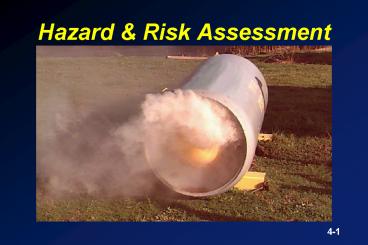Hazard PowerPoint PPT Presentation
1 / 34
Title: Hazard
1
Hazard Risk Assessment
2
Where are we?
- 1 Introduction
- 2 Awareness Review
- 3 Surveying the HazMat Incident
- 4 Hazard Risk Assessment
- 5 Intro to Incident Command
- 6 Protective Clothing Equipment
- 7 Hazardous Materials Control
- 8 Decontamination
- 9 Termination Procedures
- 10 Safety
- 11 Conclusion
3
Hazard Risk AssessmentOverview
- In the Awareness class you should have developed
skills in detecting identifying hazardous
materials, as well as in conducting a basic
hazard assessment using the Emergency Response
Guidebook
4
Hazard Risk AssessmentOverview
- In this module we will continue examining methods
for identifying chemicals and determining the
dangers involved
5
Hazard Risk AssessmentOverview
- CHEMTREC
- Emergency Response Guidebook
- Terminology
- Material safety data sheets
- EPA pesticide labels
- Other sources
- Special Incident Hazards
6
Hazard Risk Assessment
- CHEMTREC
- is an acronym for the Chemical Transportation
Emergency Center in Washington, DC, a public
service of the Chemical Manufacturers Association
7
Hazard Risk AssessmentCANUTEC SETIQ
- In Canada the equivalent of CHEMTREC is called
CANUTEC - In Mexico, the equivalent is SETIQ
- The phone numbers for both agencies are located
in the Emergency Response Guidebook
8
(800) 424-9300
FUNCTION
- 24-hour availability by phone with data on
2,800,000 chemicals - Contacts shipper or manufacturer to advise them
of spill or release
9
FUNCTION
- notifies National Response Center (NRC) of
significant incidents - can phone-link HazMat Teams with several
different chemical experts send hard copy via
computer or fax
10
Information CHEMTREC needs
- Your name, call back number, fax number
- Location and nature of the problem
- Name and identification number of the
material(s) involved - Shipper/consignee/point of origin
Carrier name, railcar or truck
number Container type and size Quantity of
material transported/released Local conditions
(weather, terrain, proximity to schools,
hospitals, etc) Injuries and exposures Local
emergency services that have been notified
11
Hazard Risk Assessment
- Try to keep a phone line connected to CHEMTREC
- CHEMTREC is continuously staffed and can provide
a teleconferencing bridge to connect experts to
your phone line as necessary
12
ERG
- The primary purpose of the Emergency Response
Guidebook is to provide guidelines for initial
action
13
ERG
- The Guidebook should not be considered as a
substitute for emergency response training,
knowledge or sound judgment
14
ERG
- In the HazMat Awareness course students were
introduced to basic concepts as identified in the
Emergency Response Guidebook
15
ERG
- At the Operations level these same concepts must
be evaluated from the context of defensive
operations that would be implemented in response
to HazMat incidents
16
ERG
- Please turn to
- Guide 117
17
Emergency Response Fire Guide 117
- Do not extinguish a leaking gas fire unless the
leak can be stopped
18
Emergency Response Small Fires (Guide 117)
Dry chemical, CO2, water spray, fog or standard
regular foam
19
Emergency Response Large Fires (Guide 117)
- Move the container from the fire area if you can
do it without risk
20
Emergency Response Large Fires (Guide 117)
- Damaged cylinders should be handled only by
specialists
21
Fire Involving TanksGuide 117
- Fight fire from maximum distance or use unmanned
hose holders or monitor nozzles
22
Fire Involving TanksGuide 117
- Cool containers with flooding quantities of water
until well after fire is out
23
Fire Involving Tanks
- Water should be directed above the point of flame
impingement and allowed to flow downward
24
Fire Involving Tanks
- This will allow the water to cool the entire tank
before evaporating
25
Fire Involving Tanks General Decision Criteria
- Emergency responders must
- know how long the flame impingement has been
occurring prior to arrival - have an excellent, sustainable water supply
- have adequate resources available to act within
a very short time
26
Fire Involving Tanks General Decision Criteria
- This concept requires enough personnel to
position these cooling streams within the first
five to ten minutes - If you do not have sufficient resources to
properly conduct this type of operation,
personnel should withdraw immediately 1,000 feet
or more
27
Fire Involving TanksGuide 117
- Do not direct water at source of leak or safety
devices icing may occur
28
Fire Involving TanksGuide 117
- Withdraw immediately in case of rising sound from
venting safety devices or discoloration of tank
29
Fire Involving TanksGuide 117
- Always stay away from the ends of tanks
30
Spill or LeakGuide 117
- eliminate all ignition sources
- all equipment used when handling the product must
be grounded
31
Spill or LeakGuide 117
- Fully encapsulating, vapor protective clothing
should be worn for spills and leaks with no fire
32
Spill or LeakGuide 117
- Do not touch or walk through spilled material
- Stop leak if you can do it without risk
33
Spill or LeakGuide 117
- Use water spray to reduce vapors or divert vapor
cloud drift - Do not direct water at spill or source of leak
- If possible, turn leaking containers so that gas
escapes rather than liquid
34
Spill or LeakGuide 117
- Prevent entry into waterways, sewers, basements
or confined areas - Isolate the area until the gas has dispersed
- Consider igniting spill or leak to eliminate
toxic gas concerns

